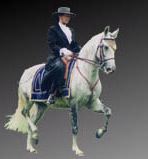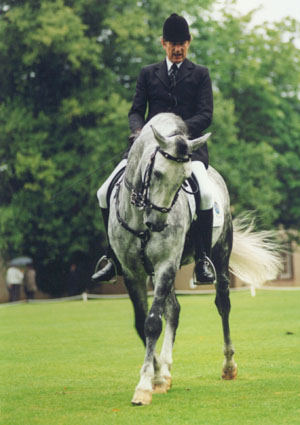 |
classicaldressagescotland.com |
| Lesson 6: Putting you horse on the aids (The first step towards putting your horse On The Bit) |
| New web address: www.classicaldressagescotland.com |  |
| About this site | About us | Personal Tuition | Video analysis | Lesson menu | Portugal and Lusitanos |
| Home Schooling Classical dressage Modern dressage Horse trials Show jumping Glossary Links |
Before you can truly put your horse on the
bit you will have to show him where you would like him to position
his head so that
To put your horse on the aids must start with the basic aids and signals to your horse to correctly negotiate a corner or a circle. If you decide that you are going to follow these methods of training, you must always ride your corners this way. Every corner should be a challenge and the perfect opportunity to teach and supple your horse. Here are the aids: 
*Your inside leg on the girth. This leg is for the horse to bend around. A reference point. Think of a skier coming down the mountain and making lots of turns. As the skier comes into a turn, he will plant his ski pole into the snow and ski round his ski pole. Think of your inside leg in the same terms. If you ride a circle, your inside leg should follow the circumference of the circle and you merely ride your horse round your inside leg. This leg will also prevent your horse falling into the circle. *Your outside leg just behind the girth but passive. This leg is guarding the horse's quarters in the unlikely event that your horse swings the quarters out of the circle (the back wheel skid). The reason I say the leg must be passive (behind the girth but not doing anything) is that if you use this leg every time you ride a corner or a circle, the leg will lose its effectiveness if you want to asked for lateral work out of the corner or if you need this leg to ask your horse to leave the track. Cause and effect, don't mend it if it ain't broke! *Your inside hand is for the bend of the neck only. This hand/rein does not say turn right or turn left. It does not steer. The reins are not handle bars. It asks for bend and flexion. The rein must invite neck bend. A take and give gesture. Don't drop your hand. That will encourage your horse to drop his inside shoulder and make the corner or circle smaller. It will also stop the horse going forward (cause a loss of impulsion). Once you have neck bend back-off with the rein. Soften it. Don't hold your horse's neck in position. If you do, he will quickly learn to hang on to that side of the bit. If your horse is reluctant to bend his neck, raise your hand a little and take it towards the opposite hip, but not across the wither. Don't do this too often. It will encourage your horse to tip his head. *Your outside hand controls the amount of bend created with the inside hand, impulsion, tempo (speed of the gait you're in) and balance. That's easy to understand isn't it!? Let's look at those individually, then. The amount of bend created with the inside hand.This means that the rein must not go forward with the neck bend. The pressure of the bit on the left side will stop you horses neck bending too far to the right side and visa versa. Impulsion.By taking and softening the rein it will control the amount of energy (impulsion) the horse is putting into the gait. Tempo. By taking and softening the rein it will control the speed (tempo) the horse is putting into the gait. Balance. Accepting the bit. This is the complicated part so be careful you understand the method and theory. Imagine you are looking at your horse in plan view (i.e. looking at him from above). Assuming you have ridden the corner correctly using the aids described above and bent him around the corner or circle, you would notice that the inside surface area of your horse becomes shorter and the outside surface area of the horse becomes longer. Your horse is stretching though the corner. Test this with a pencil rubber (eraser). Bend it and you will see what I mean. Because you have a contact in the outside rein, you can control how much your horse can stretch the outside of his body. The only way he will be able to cope with the outside bit contact and length bend is by shortening his posture. How does he do that? By giving with his jaw (dropping his head) and hopefully, in the future, by engaging his hindquarters. Lowering and sitting. As soon as your horse has lowered his head, keep the contact but soften the outside rein. If the horse has been bent correctly, your inside rein should already be soft. Here are a few tips that might help
Now your horse has been shown where you would like him to carry his head and in what position. This is the first step towards putting your horse 'On the bit' Good luck with this month's lesson. If you have any problems please email me. And as always don't forget to thank your horse with a pat, a few kind words and plenty of rests during a training session.
|